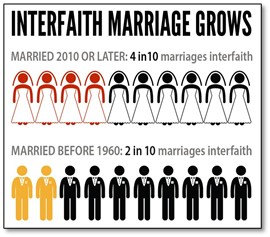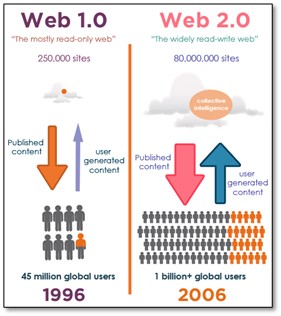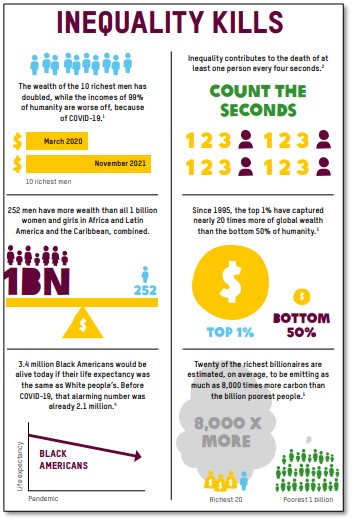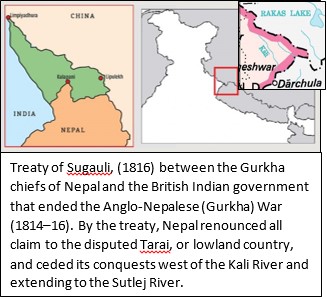Friday, 21st January 2022
Proposed amendments to the IAS (Cadre) Rules
In News
The Centre has proposed amendments to the IAS (Cadre) Rules in order to exercise greater control in central deputation of IAS officials.
Current rule on deputation
- Central deputation in the Indian Administrative Service is covered under Rule-6 (1) of the IAS (Cadre) Rules-1954. It states: “A cadre officer may, with the concurrence of the State Governments concerned and the Central Government, be deputed for service under the Central Government or another State Government or under a company, association or body of individuals, whether incorporated or not, which is wholly or substantially owned or controlled by the Central Government or by another State Government.”
- In case of any disagreement, the matter shall be decided by the Central Government and the State Government or State Governments concerned shall give effect to the decision of the Centre.
- The concurrence of any officer called for deputation to the Centre is also required.
- As on January 1, 2021, out of around 5,200 IAS officers in the country, 458 were on central deputation.
What are the proposed amendments?
Following Four amendments are proposed to Rule 6.
- If the State government delays posting a State cadre officer to the Centre and does not give effect to the Central government’s decision within the specified time, “the officer shall stand relieved from cadre from the date as may be specified by the Central government.”
- Presently, officers have to get a no-objection clearance from the State government for Central deputation.
- The Centre will decide the actual number of officers to be deputed to the Central government in consultation with the State and the latter should make eligible the names of such officers.
- According to existing norms, States have to depute the All India Services (AIS) officers, including the IPS officers, to the Central government offices and at any point it cannot be more than 40% of the total cadre strength.
- In case of any disagreement between the Centre and the State, the matter shall be decided by the Central government and the State shall give effect to the decision of the Centre “within a specified time.”
- In specific situation where services of cadre officers are required by the Central government in “public interest” the State shall give effect to its decisions within a specified time.
Why Amendment proposed?
- It was necessitated as the number of officers available under Central Deputation is not sufficient to meet the requirement of Union Government.
- Only 10% mid-level IAS officers were posted with the Union government in 2021, a sharp fall from 19% in 2014. According to the DoPT, for example, Bihar has strength of 248 IAS officers, but only 32 are posted with the Centre. Out of 180 officers in Odisha, 25 are posted with Centre.
- The existing rules did not have specific provisions to cater to situations when services of an AIS officer may be warranted in the Centre to meet specific situations such as a major disaster or national security.
- Similarly, services of an AIS officer with a specific domain expertise may be required for any important time-bound flagship programme or project. The extant Cadre Rules do not have specific provisions to cater to such situations, which have now been proposed through these amendments.
Sources:
Digital Payments Index 2021
In News
Digital Payments in India have seen a rapid growth between March and September 2021 as per the Digital Payments index (DPI), 2021 of the RBI.
About the News
- The index for 2021 September stood at 304.06 against 270.59 in March which is indicative of the rapid adoption and deepening of digital payments across the country.
- The Digital Payments Index (DPI) indicates the extent of digitisation of payments across India.
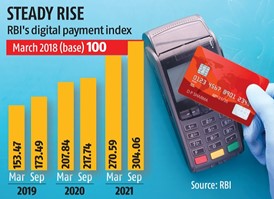
More about the Index:
- Semi Annual: The index will be published on a semi-annual basis with a lag of four months.
- Base Period: It has been constructed with March 2018 as the base period, that is, DPI score for March 2018 is set at 100.
- Objective: The index comprises five broad parameters that shows the penetration of digital payments in the country over different time periods.
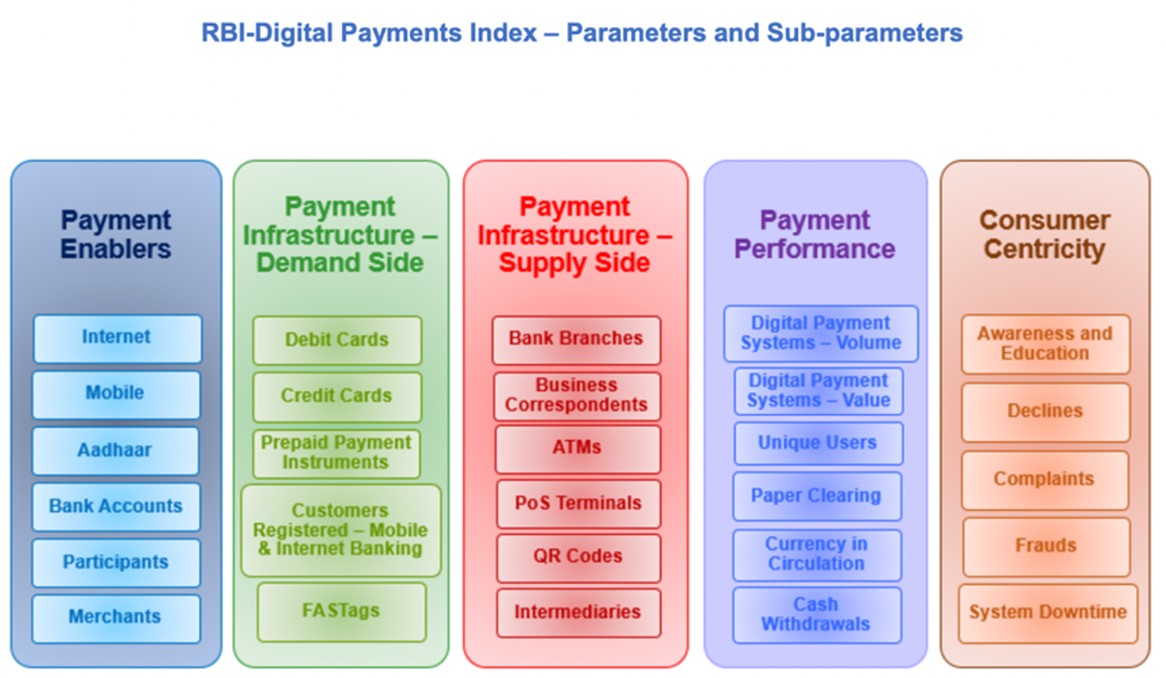
Digital Payment Trends in India
- India, on an annual basis, sees over $2 trillion in digital payments on a combination of banking apps, cards, unified payments interface (UPI), mobile wallets and government-driven direct-benefit transfers.
- UPI payments have seen the highest ramp-up and constitute $1 trillion of annualised payments followed by immediate payments services (IMPS).
- Mobile wallets’ share of transaction market is around $29 billion annually.
- Credit and debit cards at point of sale (PoS) machines annualise at $230 billion.
- The online banking platform, national electronic fund transfer (NEFT) continues to drive a dominating $3.6 trillion in annualised payments.
- Various initiatives by the government and the RBI such as the JAM trinity (Jan Dhan Bank Accounts), Aadhaar-based identification and mobile penetration, launch of platforms like UPI, mobile banking and payment gateways have led to rapid replacement of cash transactions in favour of digital transactions.
- The National Payments Corporation of India (NPCI), the umbrella organisation of digital payments in the country, is aiming to achieve 1 billion transactions per day on the UPI platform in the next 3-5 years (which is currently 31 billion transactions per year)
Source:
Flag Code of India
In News
Ahead of Republic Day, the Home Ministry has issued an advisory to all the States and Union Territories to ensure strict adherence of the Flag Code on important national events.
About the News
- The reason for the advisory was against a perceptible lack of awareness about the laws, practices and conventions that apply to display of the national flag.
- The Ministry of Home Affairs has highlighted the need to ensure the dignity of national flag as it represents hopes and aspirations of the people of the country and hence should occupy a position of honour and there is universal affection and respect for, and loyalty to, the flag.
- Rules governing national flag is governed by the Flag Code of India, 2002 which is divided into 3 parts compiling all the laws, practices, conventions, instructions and guidelines governing the display of the National Flag.
What are the current rules for the correct display of the flag?
- Conduct: The flag code mandates that the tricolour should always be distinctly placed and should “occupy the position of honour”. The flag should always be hoisted briskly and lowered slowly and ceremoniously.
- Staff projection: Flag should be projected horizontally from a window sill, balcony or front of a building, the saffron band should be at the farther end of the staff.
- Speaker’s Platform: Flag should be placed on the speaker’s right as s/he faces the audience or flat against the wall above and behind the speaker.
- Vehicle: Flag should be flown from a staff fixed either in the middle of the bonnet or the front right of the car.
- Parade: When carried in a parade, the flag should either be in the front of the centre of the line or towards the right of the file that is marching forward.
- Passing by a Parade: When the Tricolour is passing by in a parade, or during a ceremony of hoisting or lowering of the flag, the persons present should stand at attention and salute the flag. Dignitaries should remove their headgears before saluting the flag.
- Used in Funerals: In the event of the death of heads of states, dignitaries or during state funerals, the tricolour can be flown at half-mast during the period of mourning. However, if the period of mourning coincides with events of national importance, such as Independence Day, Republic Day, etc., the tricolour should not be flown at half-mast anywhere except over the building in which the body of the deceased is lying.
What are the restrictions on the display of the Tricolour according to the flag code?
- The Flag Code of 2002 is divided into three parts — a general description of the tricolour, rules on display of the flag by public and private bodies and educational institutions, and rules for display of the flag by governments and government bodies.
- No restriction on the display of the flag by public and private bodies and educational institutions except to the extent as laid down in the Emblems and Names (Prevention of Improper Use) Act, 1950 and the Prevention of Insults to National Honour Act, 1971.
- Flag cannot be used for commercial purposes, and cannot be dipped in salute to any person or thing.
- Flag should not be used as a festoon, or for any kind of decoration purposes. Any tricolour which is damaged should be destroyed in private, “preferably by burning or by any other method consistent with the dignity of the Flag”.
- Also, any paper flags, which are used on occasions of national and cultural occasions or sporting events, should not be casually discarded and must be disposed of in
- For official display, only flags that conform to the specifications as laid down by the Bureau of Indian Standards and bearing their mark can be used.
Sources:
Foundation Day: Tripura, Manipur & Meghalaya
On January 21, 1972, the three States of Manipur, Meghalaya and Tripura were formed with the enactment of North-Eastern Areas (Reorganisation) Act, 1971. Soon after India attained independence from British rule, the princely states that blended into the Indian Union started receiving statehood. During this process, Tripura and Manipur were granted with the status of Union Territories (UTs). Meanwhile, Meghalaya was still a part of Assam, and the much-famed recognition of seven sisters were not yet formed then. Similarly, in 1969, Meghalaya finally received autonomous state recognition through the Assam Reorganization (Meghalaya) Act, 1969. But it was only on January 21, 1971, with the introduction of the concerned act that all the three states – Tripura, Meghalaya and Manipur attained their much deserved recognition and became a full-fledged state.

Source:
Nuclear risks in a multipolar world
In News
Recently, the leaders of China, France, Russia, the UK and the US issued a joint statement on preventing a nuclear war and avoiding an arms race while not aiming nuclear devices at each other or at any other state.
About the News
- Declaring that they consider the avoidance of war between Nuclear-Weapon States and the reduction of strategic risks as their foremost responsibilities, the leaders of the five countries in a joint statement affirmed that a nuclear war cannot be won and must never be fought.
- However, statements and actions by the US, Russian, and Chinese leaders indicate growing tensions and the beginnings of a new nuclear arms race with rapidly receding prospects of any arms control.
- World’s nine nuclear states continued to increase spending on such weapons to a total of $72.6bn in 2020, an increase of $1.4bn from the previous year.
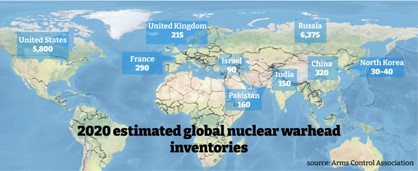
For more details on the Joint Statement, refer to: https://edukemy.com/current-affairs/gazette/2022-01-05/five-of-worlds-most-powerful-nations-pledge-to-avoid-nuclear-war
Mixed signals emerging in 2022 reflect the challenge in dealing with rising nuclear risks in an increasingly polarised world i.e. Multi-polar world. A multipolar world is one where power is distributed among several states rather than being dominated by one or two states. During the Cold War, the world was divided into two major power blocs, leading analysts to call it a 'bipolar' world.
This New strategic environment is being shaped by a confluence of conditions
- Multipolarity: Nuclear dyads are being supplanted by triads (U.S.- Russia-China; India-Pakistan-China) in which an action by one power affects the other two.
- Unconstrained arms competition: The major agreements that constituted U.S.-Russian arms control architecture has been dismantled. China, India, and Pakistan always operated outside regulatory constraints. For nuclear-weapon states, strategic autonomy is the watchword of this emerging era of unregulated competition.
- Terrorist groups, such as Al Qaeda and ISIL (Islamic State of Syria and the Levant) remain intent on acquiring a nuclear weapon.
- Territorial competition: The nuclear-weapon states are engaged in strategic competition over the territorial status quo in areas of vital interest. This contrasts with the Cold War era in which the superpowers engaged in competition, outside Europe, in the regions of the Third World.
- Rising Uncertainty and Ambiguity: Uncertainty has increased in a multi-polar world, where antagonists are not immediately obvious or their opponents readily discernible, or where non-state actors play an increasingly significant role.
- Blurring of the line between conventional and nuclear: Ballistic missile defence, hypersonic systems that carry both conventional and nuclear payloads, and growing offensive cyber capabilities further blur the line between conventional and nuclear.
- Asymmetry in Multipolarity: Multipolarity consists of more mixed set of adversarial relationships, asymmetrical contests, inadvertent signalling, and third-party exploitation of bilateral rivalries.
Emerging Dimensions of Nuclear Risk in Multi Polar World
- From Deterrent to Usable Nukes: Nuclear strategies have moved beyond the idea that we’d never use them, that they only exist as a deterrent. Now so-called ‘usable nukes’ are being developed and use postures outlined.
- Changing Nuclear Doctrine: A lot of states are expanding the role of nuclear weapons in their doctrine to include an emphasis on nuclear war fighting.
- New Arms Race: In a classic arms race behaviour, states are improving their own capabilities and then their competitors are responding to those improvements by developing systems to offset those advantages.
- New Nuclear Alliances: As part of a trilateral alliance known as Aukus to counteract the influence of China, the US and UK announced they will help Australia build a new fleet of nuclear submarines. This may spark off another race for nuclear submarines by other states.
For Details on India’s Nuclear Doctrine, refer: https://edukemy.com/current-affairs/gazette/2021-10-13/indias-nuclear-doctrine
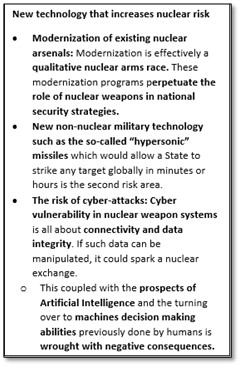
Challenges and dangers that arise in this more multifarious setting
- Increased Participants: Originally limited to the United States and the Soviet Union, competitive and potentially adversarial nuclear relationships have expanded to include, India and Pakistan, the United States and China, India and China, and the US and North Korea.
- Technological advancement: Advances in weapons technology, including cyber and artificial intelligence, raise concern over the survivability of nuclear forces, blur the line between conventional and nuclear war-fighting, risk transforming space warfare into an integral part of nuclear warfare, and, in a crisis, potentially decrease decision-making time.
- The already-contested realm of nuclear norms is growing increasingly murky and unsettled. The “nuclear taboo” seems further weakened by the attention given to the development of weapons for limited, and therefore more plausible, nuclear use.
- Nuclear-armed South Asia is a source of major concern: First, relations between India and Pakistan remain fraught and serious incidents between them occur with some regularity. The growth the China and emerging North Korea are added concerns.
- Risks of inadvertent escalation: Technological, political, and military doctrinal and operational factors could precipitate inadvertent escalation during a crisis between nuclear-weapon states.
How is the Current Mechanism incapable of handling this new threat?
- The old arms control model was a product of the Cold War, reflecting a bipolar world. The challenge now is to create an arms control model that reflects the reality of today’s multipolar world.
- Even the Joint Statement issues by the five NPT parties has failed to convey a sense of commitment to nuclear disarmament. This is because four other states possessing nuclear weapons (India, Israel, North Korea, and Pakistan) hadn’t been invited to join. Second, the statement was a collection of pious homilies, at odds with ground reality.
- Weakness of the NPT: The non-NPT cannot be part of NPT because of a quirky arbitrariness that the NPT only recognises a nuclear-weapon State if it exploded a bomb before January 1, 1967.
- We’ve had relatively little experience of nuclear deterrence in contests between giants and midgets (US v North Korea), between established and fast-rising powers (US v China), and amongst players in a multipolar system.
What can be the Model for Multipolar Nuclear Threat?
- Immediate Reforms: Member States should chart a path forward on nuclear disarmament;
- They should agree new measures of transparency and dialogue.
- They should address “simmering nuclear crises” in the Middle East and Asia.
- Strengthen existing bodies that support non-proliferation, including the UN atomic energy agency (IAEA).
- Resolving regional flashpoints: The best way to avoid conflict among nuclear-weapon states is to redouble diplomatic efforts to address the territorial disputes that could precipitate it.
- Avoid blurring conventional and nuclear operations to prevent inadvertent escalation.
- Managing complex linkages in a multipolar system: Actions taken to address one adversary in a triadic relationship can affect the other.
- The U.S. withdrawal from the INF Treaty was occasioned by Russian cheating (with deployment of a new cruise missile), but was precipitated by the theater-missile threat in East Asia posed by a risen China.
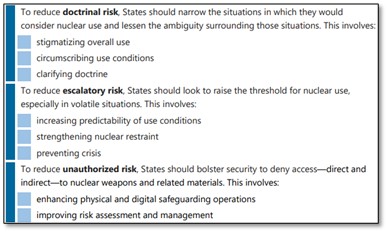
Question: Rising Multipolarity in the Nuclear Arms order has created way for a new Arms race. Elaborate
Sources:
Ancient Highways
This is image of a 4,500-year-old highway network lined with well-preserved ancient tombs, which has been discovered recently by archaeologists in Saudi Arabia. These tombs are either in the shape of pendants or rings. The pendant tombs have 'beautiful tails’ while the ring tombs have a cairn surrounded by a wall of up to two meters in height. With the help of radiocarbon dating, the researchers found that a concentrated group of samples dated back to between 2600 and 2000 BC. The team observed around 18,000 tombs along the funerary avenues. These archaeological pathways alongside oases and tombs point to an unfolding, hidden story of ancient kingdoms dating back over 4 millennia in Saudi Arabia.
Source:
Eastern Swamp Deer
Eastern Swamp Deer
- Context: Field exercise for Census of Eastern Swamp Deer has recently begun in Kaziranga National Park.
- Swamp deer (Rucervus duvaucelii) is a deer species endemic to Kaziranga National Park and Tiger Reserve (https://edukemy.com/current-affairs/gazette/2021-08-13/kaziranga-national-park-assam)
- In the Indian Subcontinent, there are three subspecies of swamp deer according to the variations in antler size namely:
- Western (R. duvaucelii duvaucelii)
- Central (R. duvaucelii branderi) and
- Eastern (R. duvaucelii ranjitsinhii).
- The western swamp deer is located in Nepal, the southern swamp deer is found in central and northern India, and the eastern swamp deer is found in the Kaziranga and Dudhwa National Parks.
- Its population is crucial for the ecological health of the tiger reserve.
- However, the population of the deer has declined from 907 in 2018, to 868 with the park's severe floods in 2019 and 2020.
- Swamp Deer is listed as Vulnerable in the IUCN Red List, listed in Appendix I of the Wildlife Protection Act of 1972 and schedule 1 of CITES.

Source:
Hybrid Terrorist
- Context: Hybrid terrorists are anticipated to be the largest challenge for security agencies in Jammu and Kashmir in 2022.
- Hybrid terrorists are those who are not listed with the security forces and are only used once or twice by the terror groups to carry out the attacks.
- Kashmir valley has witnessed dozens of hybrid terrorist attacks on civilians, policemen, political workers and minority community people in 2021.
- There are two biggest challenges with regard to Terrorism:
- Identifying hybrid terrorists: Identifying and arresting the hybrid terrorists is a big challenge which can be encountered by the use of technical gadgets and cyber patrolling.
- Narco-terror: Tons of narcotics have been recovered by security forces in various districts of the Kashmir valley and the money from these drugs is being used by terror outfits to acquire arms and ammunition.
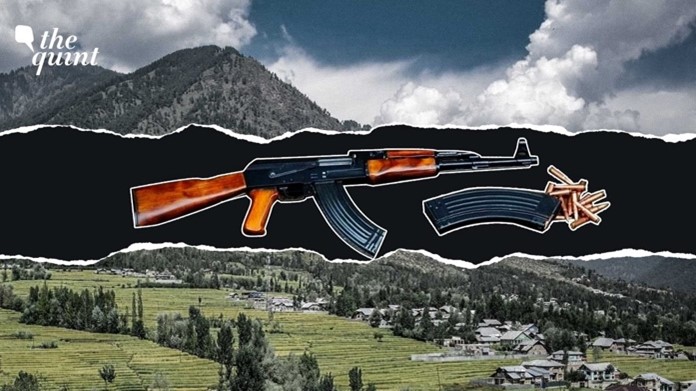
Source:
‘Saa ₹thi’ App
- Context: The Securities and Exchange Board of India (SEBI) has recently launched the Saa ₹thi app.
- It is a mobile application on investor education, designed to educate and empower investors in the securities market.
- The app aims to create awareness about the basic concepts of securities market, KYC (Know Your Customer) process, trading and settlement, mutual funds, recent market developments and investor grievances redressal mechanism, among others.
- With the recent surge in individual investors entering the market, and more importantly a large proportion of trading being mobile phone-based, this App will be helpful in easily accessing the relevant information.
- The app is available in both Hindi and English and can be downloaded in the Android and iOS The app would be made available in regional languages going forward.

Source:
Exercise Milan-2022
- Context: Over 45 countries are expected to participate in exercise Milan 2022.
- Milan is a Biennial multilateral Naval exercise hosted by the Indian Navy since 1995.
- The 2022 edition is scheduled to be held at Visakhapatnam with the theme ‘Camaraderie-Cohesion-Collaboration’.
- Final planning conference for Milan 2022 was held in hybrid format — participants attending virtually as well as physically
- It includes an International Maritime Seminar, Subject Matter Expertise Exchange, Demonstration of Submarine Rescue capability, Maritime Expo showcasing Aatma Nirbhar Bharat’, City Parade, sports activities, social, cultural and professional interactions, as also, exercises at sea.
- Over 45 countries that include Russia, the United States, the United Kingdom, Australia, Israel, Iran, France, Japan, South Korea, Vietnam, Bangladesh, Brazil, and the United Arab Emirates will be participating in the exercise.
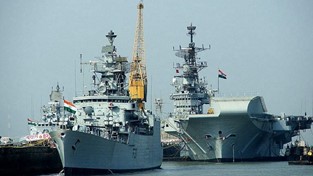
Source:
The beginning of a new nuclear arms race: ORF
Essence: The editorial highlights the dichotomy of today’s international treaties and government resolutions on nuclear arms and its non-proliferation. While the five nuclear weapon states of NPT declared that “a nuclear war cannot be won and must never be fought” and underlined that nuclear weapons “serve defensive purposes”, their actions speak otherwise. USA’s 2018 Nuclear Posture Review spoke of widening the type of nuclear arsenal to cater to both conventional and nuclear threats and attacks. Similarly, China would double its nuclear arsenal with tailored and flexible low-yield weapon. Russia too has deployed evasive nuclear capable ICBMs and torpedos.
These developments serve the purpose of further destabilizing the world order. This volatility is leading to further proliferation of nuclear weapons by newer states- Iran, North Korea, etc. The NPT and the Treaty on Prohibition of Nuclear Weapons, signed in 2021, is not inclusive. There is a certain need for an all-inclusive nuclear control regime catering to the multi-polar world order of today.
Why you should read this article?
- To understand the new developments in nuclear arsenal by the NPT nations.
- To analyze the reasons for nuclear arms race around the world, especially amongst the non-nuclear nations.
Source:
Has India lost its demographic sweet spot?: HBL
Essence: The article has elaborated on the reasons that why achieving a growth rate of 8-9 percent GDP is difficult for India to achieve. Decreasing fertility rate of India, coupled with decline in Productivity rate due to high debt are the main reasons. The article also explains how the protectionist policies may further hamper growth.
The article also explores the remaining possibilities that need to tapped for effective growth rate in India. These include letting loose protectionist tendencies and let the export grow to normalize the trade. India needs to focus on skilling and re-skilling of the labor force so that they can take the available jobs in the market. At the same time the government should brace itself to tackle the challenges which could be posed by demographic changes. To reskill and educate people, investment in education alone will not suffice, the need is to map the skill requirement for future. A prudent economic policy is what India needs to get back its high growth rate which will help India take advantage of its demographic dividend.
Why you should read this article?
- To understand why India is losing on its demographic dividend.
- To understand the reasons that is curtailing the growth rate of the country.
- To understand the steps that could be taken to bring the economy back on track.
Source:
The centrality of data equity in tech policy and reform: HT
Essence: Digitization has taken a leapfrog during and after the pandemic. The government took significant steps to control tech policy in personal and non-personal data, health and financial data, and data related to e-commerce etc. Several legislation have been enacted in this regard, but they all raise the question of data equity.
Data equity is a wide word that refers to a complex architecture. It focuses on the methods for gathering, assembling, storing, scrutinising, evaluating, processing, and disseminating data. Any discussion of equity assumes the existence of a weaker entity, stakeholder, or set of entities than a stronger group of similar stakeholders. This discussion raises the issue of power imbalances between these various groupings. The article elaborates on the many facets of Data Equity. Assuring data equity is a crucial step in pursuing measures that promote impartiality and justice.
Why should you read this article?
- To grasp the concept of data equity.
- To be aware of various techniques, the issues that data equity entails, and possible solutions.
Source:
A service to Humanity
Background
- Himanshu Kalia and his wife Twinkle created free ambulance services to transport persons in need of immediate medical assistance around Delhi after their father nearly died owing to delayed services.
- So far, they have helped 80,000 patients. Twinkle was awarded the Nari Shakti Puraskar by India's President in 2019.
Work done by the Couple:
- The couple carry out their services under a trust by the name of Shahid Bhagat Singh Help and Care for Society.
- Initially, it was difficult to identify needy patients. So, they put up posters and circulated phone numbers to raise awareness.
- They perform last rites, cremate bodies abandoned by families, and provide other ambulance services to people who cannot afford them. This was especially very helpful during the Covid-19
- Despite sufferings at financial and personal front. There is no steady financial help, but some individuals offer occasional support.
- The duo has received countless honors for their sacrifices and dedication. The Delhi Gaurav Honor, given in 2015, and award on International Women's Day 2021, are two examples.

Quote: “Service to mankind is service to God” -Swami Vivekanand
Source:
Share the article
Get Latest Updates on Offers, Event dates, and free Mentorship sessions.

Get in touch with our Expert Academic Counsellors 👋
FAQs
UPSC Daily Current Affairs focuses on learning current events on a daily basis. An aspirant needs to study regular and updated information about current events, news, and relevant topics that are important for UPSC aspirants. It covers national and international affairs, government policies, socio-economic issues, science and technology advancements, and more.
UPSC Daily Current Affairs provides aspirants with a concise and comprehensive overview of the latest happenings and developments across various fields. It helps aspirants stay updated with current affairs and provides them with valuable insights and analysis, which are essential for answering questions in the UPSC examinations. It enhances their knowledge, analytical skills, and ability to connect current affairs with the UPSC syllabus.
UPSC Daily Current Affairs covers a wide range of topics, including politics, economics, science and technology, environment, social issues, governance, international relations, and more. It offers news summaries, in-depth analyses, editorials, opinion pieces, and relevant study materials. It also provides practice questions and quizzes to help aspirants test their understanding of current affairs.
Edukemy's UPSC Daily Current Affairs can be accessed through:
- UPSC Daily Current Affairs can be accessed through Current Affairs tab at the top of the Main Page of Edukemy.
- Edukemy Mobile app: The Daily Current Affairs can also be access through Edukemy Mobile App.
- Social media: Follow Edukemy’s official social media accounts or pages that provide UPSC Daily Current Affairs updates, including Facebook, Twitter, or Telegram channels.

